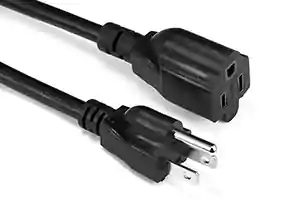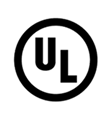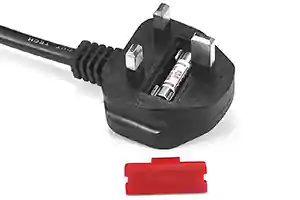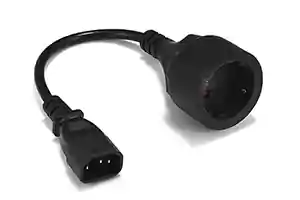The Type A plug (or flat blade attachment plug) is an ungrounded plug with two flat parallel pins. Although the American and Japanese plugs appear identical, the neutral pin on the American plug is wider than the live pin, whereas on the Japanese plug both pins are the same size. Di conseguenza, Japanese plugs can be used in the US but often not the other way around.
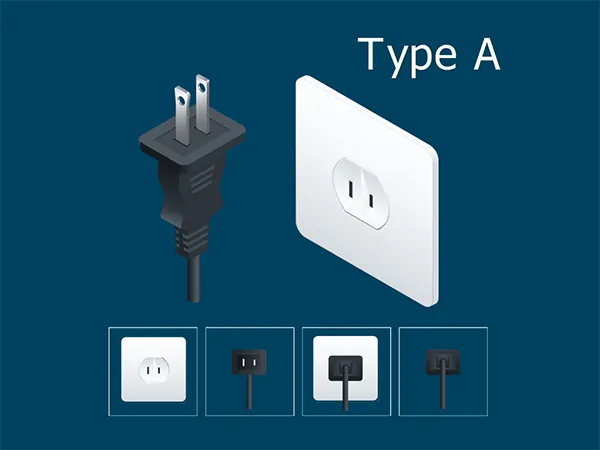
What is Type A plug?
This class II ungrounded plug with two flat parallel prongs is pretty much standard in most of North and Central America. It is known as NEMA 1-15 and was invented in 1904 by Harvey Hubbell II. The plug has two flat 1.5 lame di spessore mm, misurando 15.9 – 18.3 mm in length and spaced 12.7 mm di distanza.
Type A plugs are generally polarised and can only be inserted one way because the two blades do not have the same width. The blade connected to neutral is 7.9 mm wide and the hot blade is 6.3 mm wide. This plug is rated at 15 UN. Da quando 1965, ungrounded type A outlets are not permitted anymore in new constructions in the United States and Canada, but they can still be found in older buildings.

Type A and B plugs have two flat prongs with (often, but not always) a hole near the tip. These holes aren’t there without a reason.
If you were to take apart a type A or type B socket and look at the contact wipers that the prongs slide into, you would find that in some cases they have bumps on them. These bumps fit into the holes so that the outlet can grip the plug’s prongs more firmly. This prevents the plug from slipping out of the socket due to the weight of the plug and cord. It also improves the contact between the plug and the outlet. Some sockets, Tuttavia, do not have those bumps but just two spring-action blades that grip the sides of the plug pin, in which case the holes are not necessary.
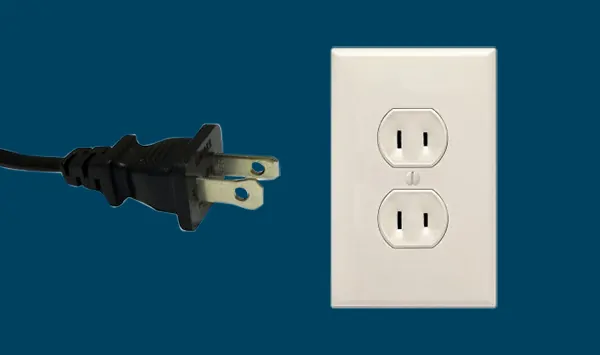
There are also some special outlets which allow you to lock the cord into the socket, by putting rods through the holes. In this way, vending machines and the like cannot be unplugged. Inoltre, electrical devices can be factory-sealed by the manufacturer using a plastic tie or a small padlock through one or both of the plug prong holes. standard, a manufacturer might apply a plastic band through the hole and attach it to a tag that says: “You must do X or Y before plugging in this device”. The user cannot plug in the device without removing the tag, so the user is sure to see the tag.
What countries use Type A plug?
Countries using type A electric plug:
Samoa americane
Anguilla
Antigua e Barbuda
Aruba
Bahamas
Belize
Bermude
Bolivia
Isole Vergini britanniche
Cambodia
Canada
Isole Cayman
Cina
Colombia
Costa Rica
Cuba
Dominican Republic
Ecuador
Il salvatore
Guam
Guatemala
Guyana
Haiti
Honduras
Giamaica
Giappone
Corea, Democratic Peoples Republic of
Repubblica Democratica Popolare del Laos
Libano
Liberia
Malaysia
Messico
Micronesia, Stati Federati di
Montserrat
Antille Olandesi
Nicaragua
Palau
Panama
Perù
Filippine
Porto Rico
Repubblica del Niger
Saint Kitts e Nevis
Saint Vincent e Grenadine
Taiwan
Tailandia
Trinidad e Tobago
Isole Turks e Caicos
Stati Uniti
Isole Vergini americane
Venezuela
Viet Nam
Yemen
Does China use Type A plug?
For China there are three associated plug types, types A, C, and I. Plug type A is the plug which has two flat parallel pins, plug type C is the plug which has two round pins, and plug type I is the plug which has three flat pins in a triangular pattern. China operates on a 220V supply voltage and 50Hz.
Ora è il tuo turno
So that’s how I understand Type A plug and socket.
Ora voglio consegnarlo a te: Attraverso il mio articolo, do you understand What is Type A Plug and Socket (Presa)?
Do you have a different point of view with the power plug type A? O qualsiasi altra domanda?
Fammi sapere lasciando un breve commento qui sotto in questo momento.
